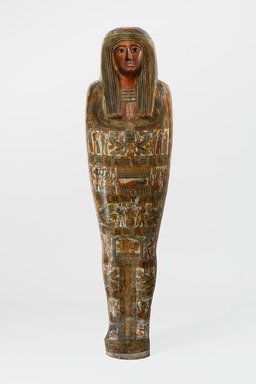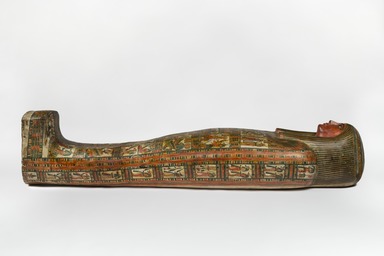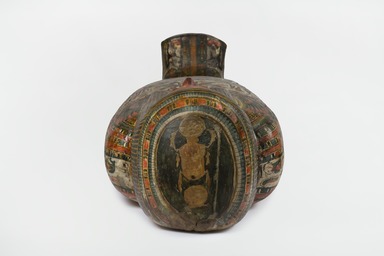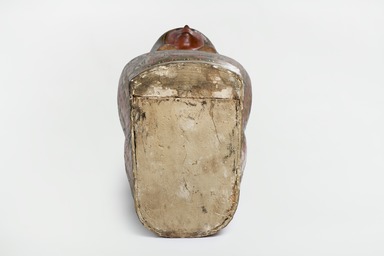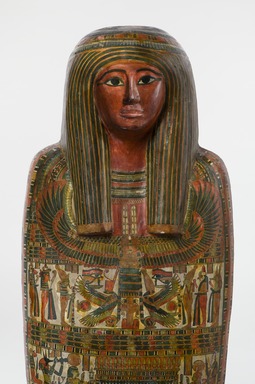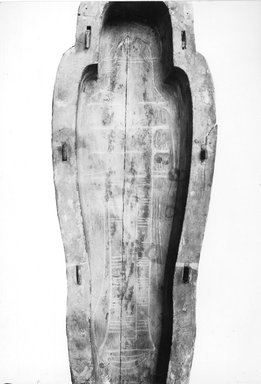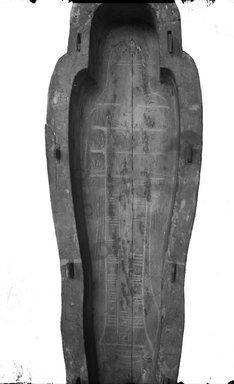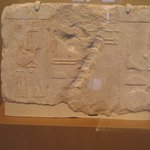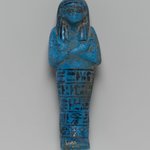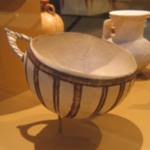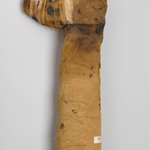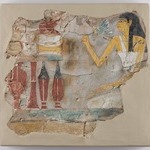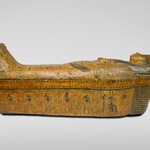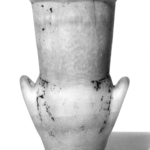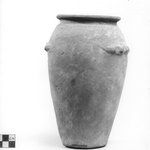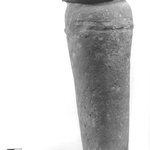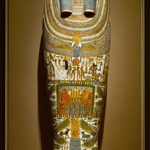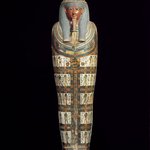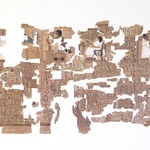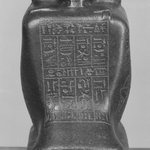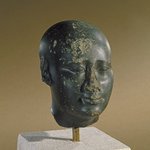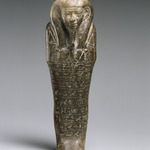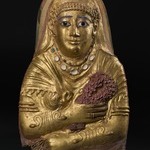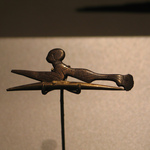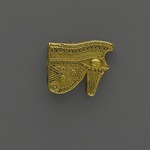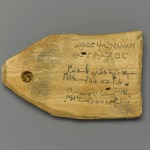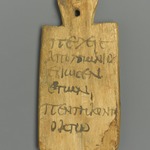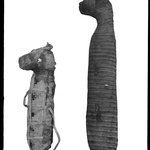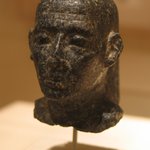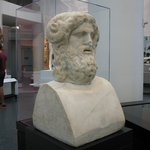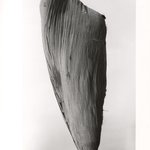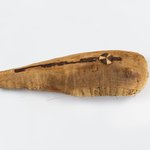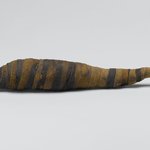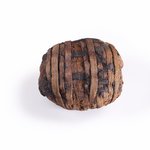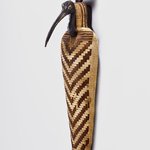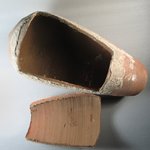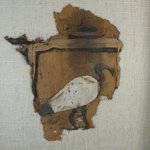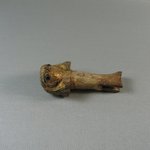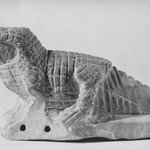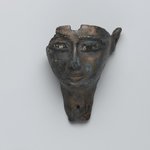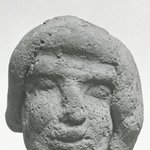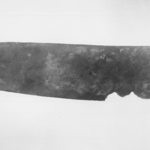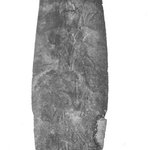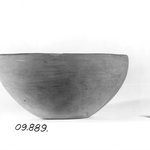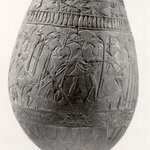I'm going to be volunteering here soon and I need to learn more about the collections. How many mummies are here? Is the mummy still in Nespanetjerenpere's container?
Their are four mummies on view. "Mummy and Cartonnage of Hor," "Anthropoid Coffin of Thothirdes," "Inner Cartonnage of Gautsesheni," and "Cartonnage and Mummy." Nespanetjerenpere's cartonnage is empty, the mummy has been lost.
Hor and Gautsesheni are inside of their cartonnages so you can't actually see the mummies themselves, but those two are in there. You can see Thothirdes and one more unnamed mummy. Those would be the two the kids are really after!
Were the mummies ever placed or stored standing up in ancient Egypt?

Mummies were laid down when they buried, but were stood up like this for various ceremonies during the funeral. This position also makes it easier to see imagery and the craftsmanship of the cartonnage which contributes the curators' choice to display them upright.
Was everyone allowed to be a mummy?
Yes! Mummification was part of burial practices for every Egyptian. The very wealthy could obviously afford a much more elaborate mummification process. There are three known methods for Mummification, each is sharply divided by price. The most expensive involved removing internal organs and a very long process of drying the body via salt and other compounds. The cheapest method involved liquifying the internal organs and later draining them though the deceased anus.
My daughter wants to know: why are the mummy coffins so small?
Great question! To start, ancient Egyptians were noticeably shorter than people today. The rest of the answer is a bit ooky.
Ok, she's ready for ooky.
Mummification involves the removal of most internal organs, and fluid from the body. Once all of the fluids are drained from a body, they shrink a lot and are a great deal smaller. So body containers for mummified individuals are smaller than one would expect. Mummification took a total of 70 days to drain all the liquid from a body so people were very shrunken.
Is the mummification process well documented?
There is some documentation of the process. Egyptologists have also done a number of experiments in recent years on the process to figure out how the ancient Egyptians did it.
The ancient Greek historian Herodotus described three ways of mummifying bodies in his writings. He had traveled to Egypt in the 5th century BCE.
The different types of mummification that one could undergo after death depended on the cultural ideas at the time, such as our later period examples with Greco-Roman mummy portraits, and the amount of money one had.
Ah money.
I had never seen this. How come museums rarely exhibit the mummies themselves?
Some museums simply don't have them in their collections. Our Egyptian collection is very old, many objects on view came to the United States in the nineteenth century. Our curator believes that there is artistic value in the wrapped mummies we have on display, which is why they're presented as such.
Cool. Thanks!
My son wants to know what kind of cloth the mummies were wrapped in?
The mummies are wrapped in linen. You can see the outer linen wrappings of Demetrios and our Anonymous Man. Hor's mummy is encased in cartonnage which is made from linen and plaster.
Are there any bones in the mummies in the Mummy Chamber?
Yes, in fact the bones are largely what survives of the body. The mummies will often still have skin because of the preservation process (if the mummification was originally well done).
Tell me more.
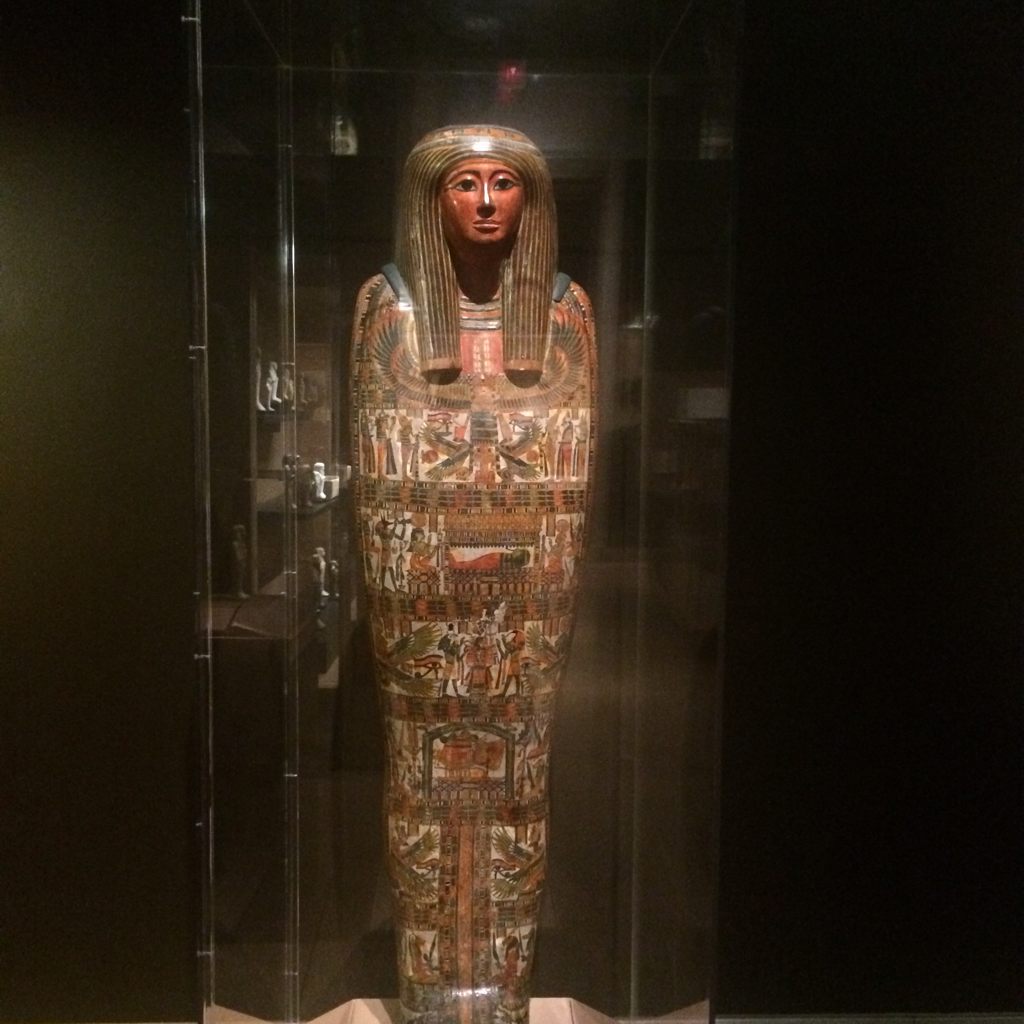
Hor lived in the 7th century BCE and the images on his cartonnage are designed to help him on a successful journey to the afterlife. They include scenes of his own funeral, the figure laying on a bed in the middle represents the mummified Hor.
Why is there a standing up mummy on the 4th floor?
It sounds like you're asking about Hor. The curators included him in the Soulful Creatures exhibition to show the way that humans were mummified next to the animals so you can compare. And, you can see all the animal-headed gods that were included on his cartonnage.
Tell me more.
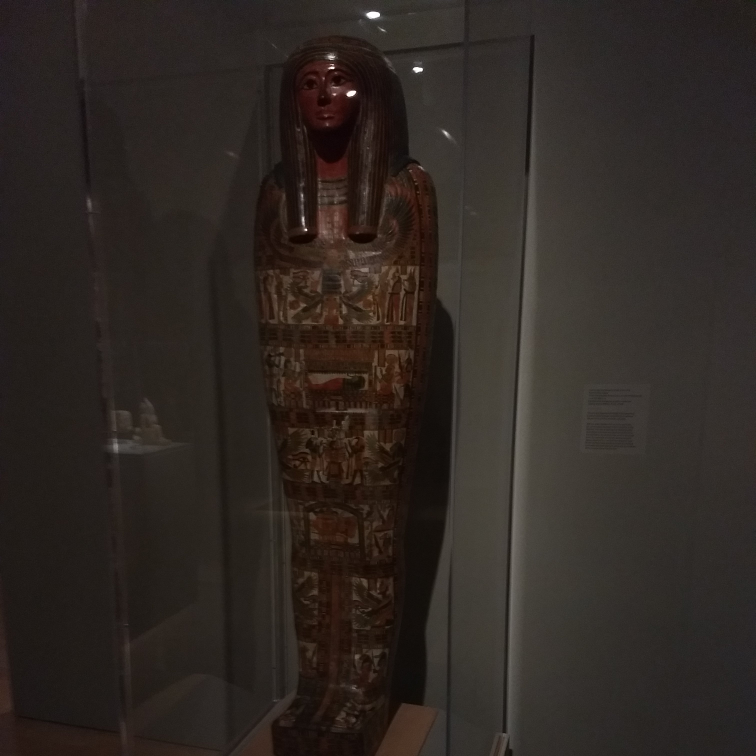
The cartonnage of Hor, and his mummy inside, are included in the Soulful Creatures exhibition to illustrate some and the ancient Egyptians' beliefs about the power of animals. Did you notice all the animal-headed deities on the sides?
I didn't, that's awesome thank you
You're welcome! This type of container served to identify, protect, and transform the deceased assisting in their journey from the world of the living into the world of the dead. The animal-deities helped protect Hor's body and soul through his journey.
Who are the people here?
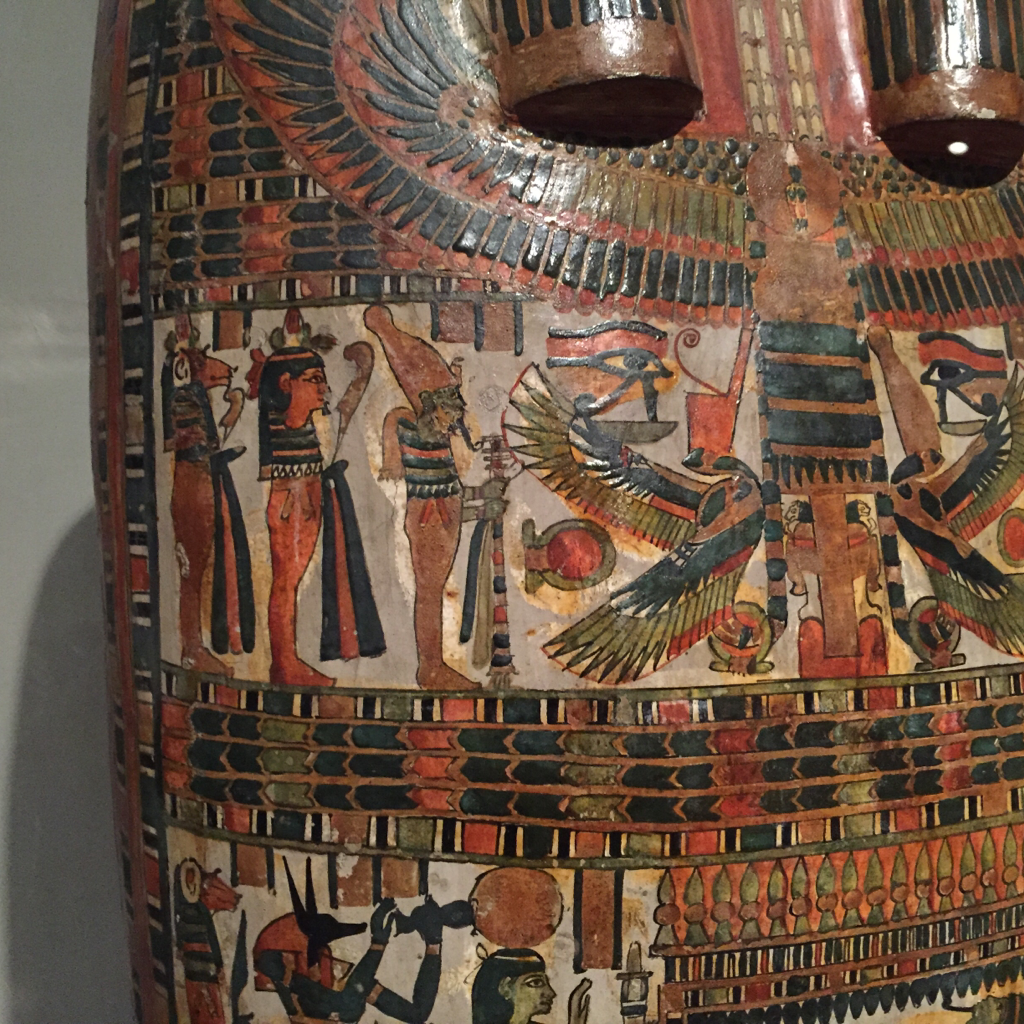
This closeup of the Cartonnage of Hor shows us several ancient Egyptian deities and demons. Here you can see the center of the cartonnage's chest is covered by a Ta-wer symbol, a ceremonial standard of the town of Abydos. The symbol is flanked by two winged cobra deities, each wearing one of the crowns of either Lower or Upper Egypt, indicating that they are the goddesses of Lower and Upper Egypt, Wadjet and Nekhbet.
Next to the cobra headed deities on either side is a version of the mummiform King of the Afterlife, Osiris. Next to each Osiris stands two of the four sons of Horus, the figures also found on canopic jars to guard organs.
There is so much decoration on this!
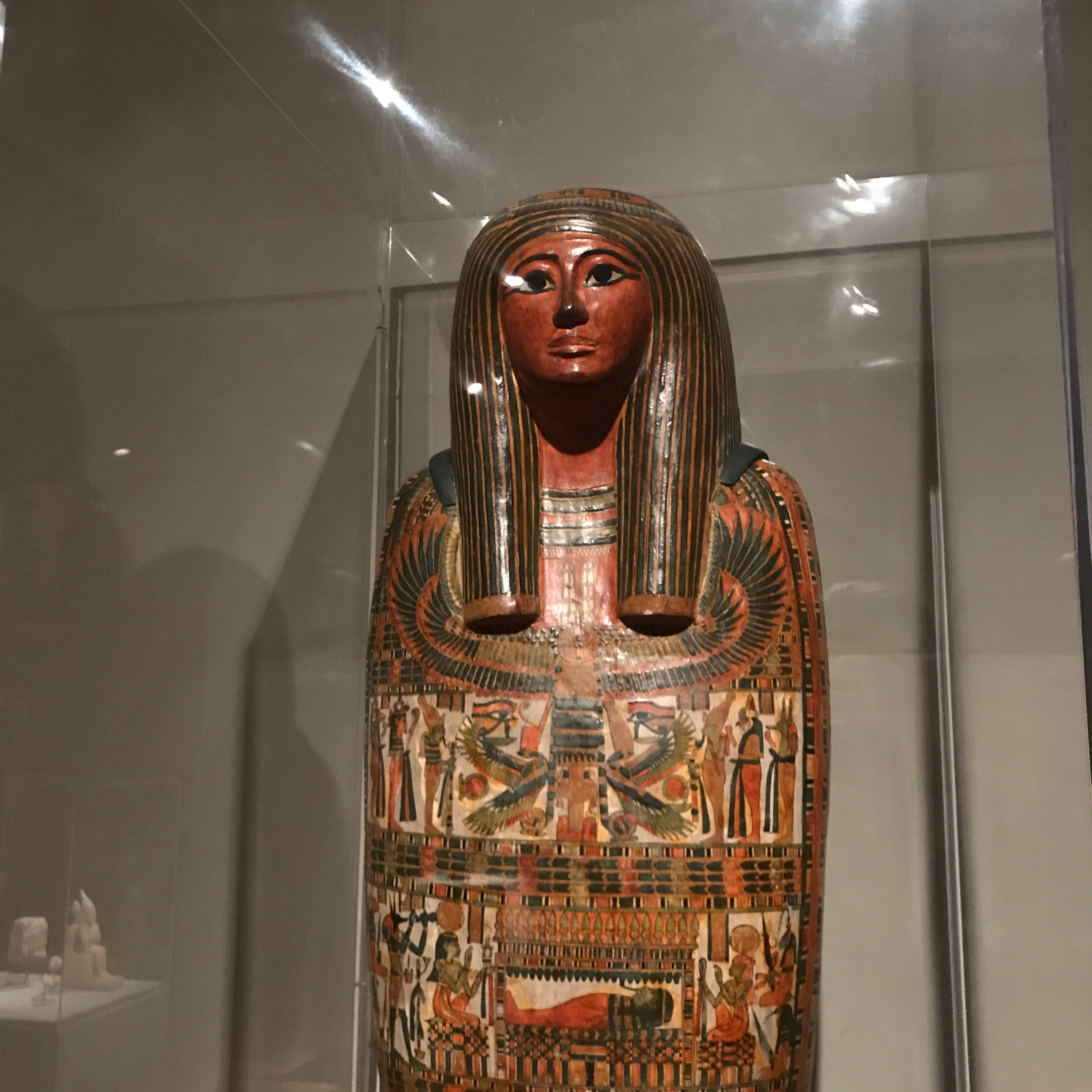
The cartonnage of Hor is elaborately decorated, the designs aimed at helping him have a successful journey into the afterlife. On his cartonnage we see scenes including his own funeral. You can see him in the center of the painting, mummified and laying on a bed!
Several deities also appear in the painting, including the mummiform King of the Afterlife, Osiris, and, next to Osiris, the four sons of Horus. The four sons of Horus were also associated with canopic jars, guarding and preserving the organs of the deceased.
Who is this god with a crane's head?

That is Thoth, the god of wisdom and writing. I see why you would call it a crane, but is actually an ibis, another type of bird!
The bird's long, curving beak resembles the reed pens used by scribes.
Thanks!
Is this a woman ?
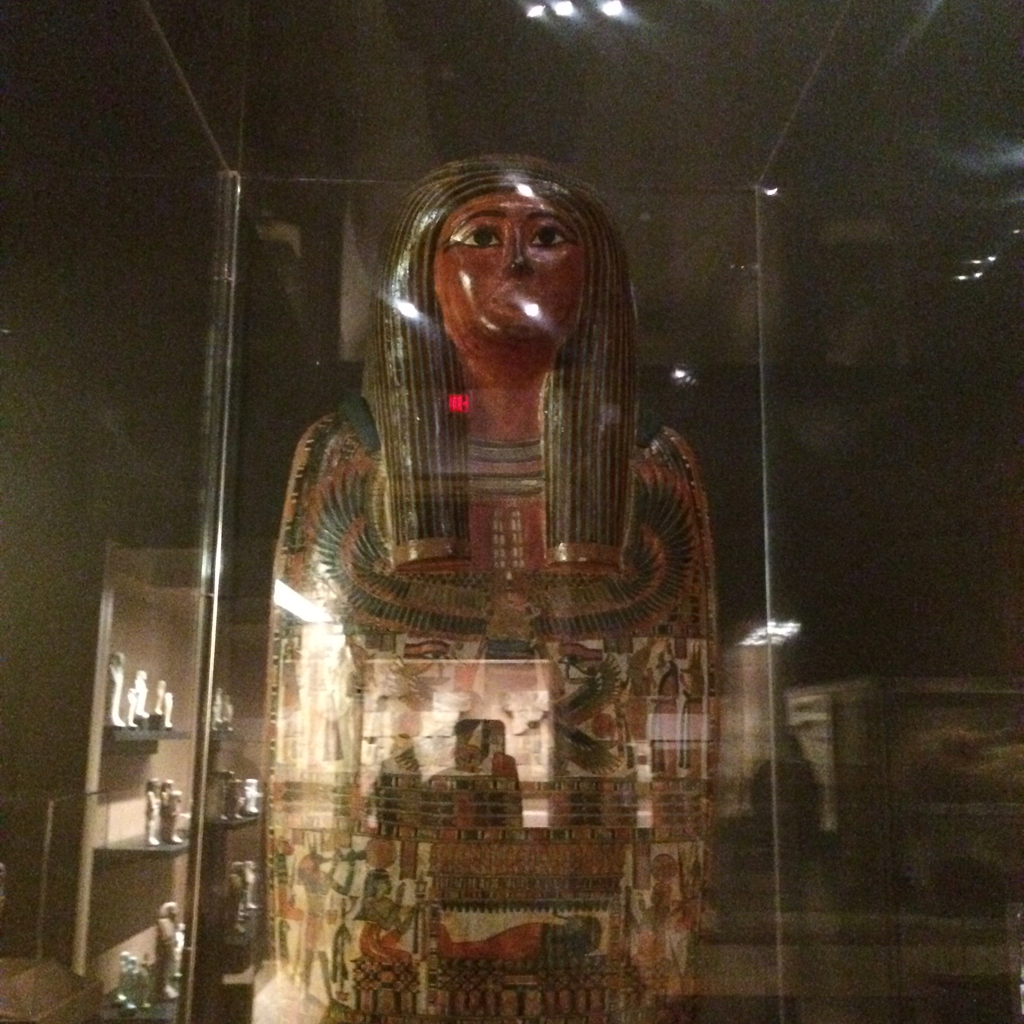
That is the Catonnage of Hor. Hor is a man. The ancient Egyptians generally painted men with reddish skin, and women with yellowish or white skin, which you can learn more about in the "A Woman's Afterlife" exhibition nearby.
Are there any real mummies/bodies here?
There are! There are four mummies currently on view and they are all in the Mummy Chamber section at one end of the Egyptian galleries on the third floor.
The mummies of Thothirdes and an anonymous man are laying down in cases, and the decorated cartonnages of Gautseshenu and Hor also contain their mummies.
This sign indicates that they used to not be displayed, why is that? Were there ethical considerations?

The museum certainly does make ethical considerations when displaying human remains, you may have noticed that this space is quite dark and contemplative. Some mummies are always kept in storage for conservation reasons. This sign refers to a previous approach to the installation of the Egyptian galleries, I believe before 2003. There was a period when many mummies in many institutions were removed from the galleries in an effort to be more respectful. More recently, we, and other institutions, have begun to return them to the galleries in new and (hopefully) more ethical contexts.
Ahhh understood, thanks.
How did the Brooklyn museum acquire these mummies?
Three of the mummies in the gallery, Thothirdes, Hor, and Gautseshenu, we acquired from the New York Historical Society with their entire collection of ancient Egyptian art.
The anonymous man we acquired from the Metropolitan Museum of Art, who sponsored the excavation that found the mummy in 1929.
Thanks again for all the great answers today.
Would you know which cranial bone was cracked to drain the brain during the mummification process?
I am not an expert in anatomy, so I do not know the scientific name of the particular bone, but I can tell you that the brain was removed through the nose by means of a hook that was inserted into the nostril and used to break into the brain cavity.
Thank you.
And would you be able to tell me more about natron?
Natron is a naturally occurring mineral very common in the geology of Egypt that is made up of multiple sodium-based compounds. The longest, and scientifically most important, part of the ancient Egyptian mummification process was to pack the body in this salt-like substance in order to draw out all moisture. The modern word, natron, comes from Wadi Natrun where the ancient Egyptians mined the mineral. The chemical symbol for sodium, Na, also has the same root.
